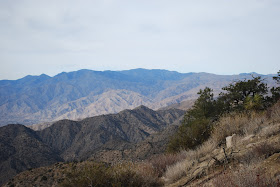

We spent four days at Black Rock Campground in Joshua Tree National Park, and hiked a total of 26 miles (estimated total elevation gain 4000-5000 ft).
Vicky and I both feel it was an experience unlike anything we've ever had, and it so far surpassed our hopes for it that it will forever be one of our very favorite places.
Neither of us knew anything about Joshua Tree National Forest, or even knew what a Joshua Tree was for heaven's sake. All we knew was that it was in the area we wanted to explore, and that there was abundant hiking. And there was supposed to be decent weather.
Our plan had been to spend three nights there, and hike three days. On the morning of the fourth day, we both realized that there was no reason to not spend another day, with the possible exception that it meant another day without a shower. We felt really good to be able to do this--one big reason was that it meant that everything we had prepared for had worked.
What had worked was that we had taken this old worn out camper and had given it new life, with many repairs and alterations.
We spent money on new propane equipment, for safety reasons and to make sure we had enough energy for our lamps, stove, oven, and heater.
We reconfigured the water system, so that we could carry about 30 gallons of water and when it drained out the sink it would go to what had formerly been the dump tank for the toilet. Then, we could empty this dump tank into a sewer later. This is, in RV lingo, "gray water," which really is no different from water left over from cooking and cleaning that one would create if one were tent camping. However, for RV camping, we knew that some campgrounds wouldn't allow just running that water into the site (even though there were no such rules for those tent campers who create the same type of waste water, as most just dump it on a bush or something).
We had installed a new propane lamp, and a new, spare battery for the camper. Our "refrigerator" no longer worked, but we found that with block ice, it kept our food plenty cold.
The camper was comfy, safe, and practical. And inexpensive.
So we realized that we had enough food, enough "energy" (in the camper batteries and in propane), enough water, enough room in our dump tank, and enough ice in our freezer to stay another day if we wanted. And we wanted.
The campground was mostly empty, so we picked a spot at the back, and were basically by ourselves for all four days. On a couple of nights we couldn't even see other campers. For the other two nights, we could see three or four.
It felt like we were all alone in the world—nothing and nobody even close to us. The hikes added to this feeling, in that of the four we did, we only ran into two other groups and a single hiker on the first one, and a couple of horse riders on the second one. For the other two, including the one that was so memorable that I will write a separate blog entry for it, we were all alone--seeing no one.
The nights were cold and windy—gusts up to 50 mph one night, which really rocked the camper. Rain the following night. But we cozied up, with our 41-year-old propane-fired furnace, and were fine.
Joshua Tree National Park is considered high desert. There are a few cacti, but not many. Nothing grows very large here, and there are lot of open spaces. Black Rock Campground is at the western edge of Joshua Tree, and apparently the terrain differs in other regions. We'll find out on another trip. But even within the 26 miles of hikes we took we ran into different types of terrain.
Typically our hikes were along arroyos, in deep sand, usually with a steady upward slope. I imagine it all looks different in the spring when plants and trees are blooming, but it was beautiful enough now. Through these areas we could usually hike next to each other, which was nice.
Then, at times, we would climb through narrow ascending trails.
The vegetation depended somewhat upon where we were. At lower elevations there were, of course, the Joshua Trees, which covered the landscape in most of the areas we hiked. They are about 20 feet tall, with sharp "leaves." One didn't want to brush up against one while hiking.
There are also a lot of bushes, all dormant for the winter, but of different colors--purples, greens, and yellows.
In some of the higher areas we ran into pine trees, some with normal sized pine cones, and some with itty bitty pine cones:
Here is some of the other vegetation:
These trees were covered with small "blueberries." We didn't try any, but the Scrub Jays liked them.
Depending on the day, the time of the day, and where we were, we were cold, warm, or just right. The wind blew a lot most days, which I don't believe is typical for this climate. Some wind is usual, I think, but the gusts we experienced were strong. We were always taking off and putting on different clothes. You can see the variations in outfits in the photos we took of ourselves:
The views were often stunning. One after the other.
Every evening we would fix a nice meal, relax, me with wine, talk about our day, and plan our next one. At night the wind would howl, one night it rained hard, and the other nights were just perfect. The night sky was alive with bright stars.
Our view out our front window in the mornings was breathtaking:
We were alone at the edge of the world.
























No comments:
Post a Comment